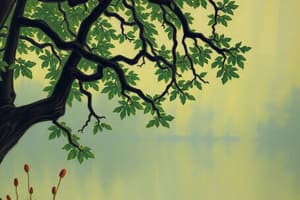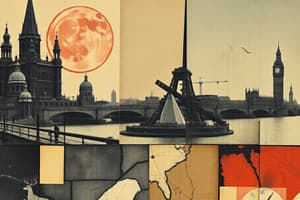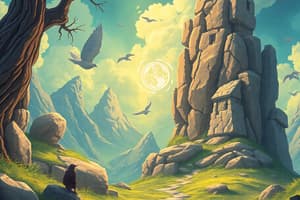Podcast
Questions and Answers
Which river is associated with the Harappan Civilization?
Which river is associated with the Harappan Civilization?
- Amazon River
- Indus River (correct)
- Nile River
- Ganges River
Which of the following best describes a theocracy?
Which of the following best describes a theocracy?
- A government run by religious figures. (correct)
- A system of government led by elected officials.
- A city and the surrounding villages and farms.
- A form of government based on bureaucratic rules.
All ancient societies were monotheistic.
All ancient societies were monotheistic.
False (B)
Judaism is considered the world's oldest polytheistic religion.
Judaism is considered the world's oldest polytheistic religion.
What type of farming characterized the early societies mentioned?
What type of farming characterized the early societies mentioned?
Who is considered the founder of Judaism?
Who is considered the founder of Judaism?
Classical civilizations were more advanced than _____ civilizations.
Classical civilizations were more advanced than _____ civilizations.
Cuneiform was developed by the ______.
Cuneiform was developed by the ______.
Match the following civilizations with their key features:
Match the following civilizations with their key features:
Match the following terms with their descriptions:
Match the following terms with their descriptions:
Which of the following is NOT a defining characteristic of early societies?
Which of the following is NOT a defining characteristic of early societies?
China was influenced heavily by neighboring civilizations due to its geographical features.
China was influenced heavily by neighboring civilizations due to its geographical features.
What was the primary philosophy underlying the Qin Dynasty's approach to governance?
What was the primary philosophy underlying the Qin Dynasty's approach to governance?
The caste system allowed individuals to move freely between different social classes.
The caste system allowed individuals to move freely between different social classes.
What is a common feature of many ancient societies in terms of religion?
What is a common feature of many ancient societies in terms of religion?
What was the primary trade route connecting China to the Mediterranean?
What was the primary trade route connecting China to the Mediterranean?
The Silk Road facilitated the exchange of goods and ideas, including the spread of __________.
The Silk Road facilitated the exchange of goods and ideas, including the spread of __________.
Which dynasty is known for its civil service system that required difficult examinations for government positions?
Which dynasty is known for its civil service system that required difficult examinations for government positions?
Match the social classes of the caste system with their roles:
Match the social classes of the caste system with their roles:
The Han Dynasty lasted longer than the Qin Dynasty.
The Han Dynasty lasted longer than the Qin Dynasty.
What regions did Rome conquer to create its empire?
What regions did Rome conquer to create its empire?
What was a major outcome of the Neolithic Revolution?
What was a major outcome of the Neolithic Revolution?
The term 'Neolithic Revolution' refers to the transition from a sedentary lifestyle back to nomadic living.
The term 'Neolithic Revolution' refers to the transition from a sedentary lifestyle back to nomadic living.
What role did geography play in the development of early civilizations?
What role did geography play in the development of early civilizations?
The Neolithic Revolution began around _____ BCE and ended around _____ BCE.
The Neolithic Revolution began around _____ BCE and ended around _____ BCE.
Match the ancient civilizations with their respective locations:
Match the ancient civilizations with their respective locations:
Which of the following is NOT one of the five characteristics of a civilization?
Which of the following is NOT one of the five characteristics of a civilization?
Jared Diamond believed that farming was beneficial and had no negative consequences for human society.
Jared Diamond believed that farming was beneficial and had no negative consequences for human society.
What was the significance of Catal Huyuk during the Neolithic Era?
What was the significance of Catal Huyuk during the Neolithic Era?
Which of the following best describes polytheism?
Which of the following best describes polytheism?
Pastoralism primarily involves the cultivation of crops.
Pastoralism primarily involves the cultivation of crops.
What describes the role of a pharaoh in ancient Egyptian society?
What describes the role of a pharaoh in ancient Egyptian society?
The _____ is a temple that was built to lead to the sky.
The _____ is a temple that was built to lead to the sky.
Match the civilization with its defining feature:
Match the civilization with its defining feature:
What is a significant factor leading to the rise of civilizations?
What is a significant factor leading to the rise of civilizations?
The Out of Africa Theory suggests that human evolution began in Europe.
The Out of Africa Theory suggests that human evolution began in Europe.
What is the difference between interpretive history and factual history?
What is the difference between interpretive history and factual history?
What was the purpose of oracle bones in Ancient China?
What was the purpose of oracle bones in Ancient China?
The Mandate of Heaven allows people to maintain their dynasty indefinitely.
The Mandate of Heaven allows people to maintain their dynasty indefinitely.
What were the two main cities of the Indus River Valley?
What were the two main cities of the Indus River Valley?
_______ is the belief that one's own culture is superior to others.
_______ is the belief that one's own culture is superior to others.
Which of the following is NOT a characteristic of the Neolithic Revolution?
Which of the following is NOT a characteristic of the Neolithic Revolution?
Match the following Chinese philosophies with their founders:
Match the following Chinese philosophies with their founders:
The primary writing system in Ancient Egypt was known as hieroglyphics.
The primary writing system in Ancient Egypt was known as hieroglyphics.
The system that supplies water to land or crops is called an __________ system.
The system that supplies water to land or crops is called an __________ system.
Which of the following is a characteristic of historians?
Which of the following is a characteristic of historians?
Geographers study both topography and human environments.
Geographers study both topography and human environments.
What are two types of sources that historians study?
What are two types of sources that historians study?
The ____ Age is characterized by the development of agriculture and permanent settlements.
The ____ Age is characterized by the development of agriculture and permanent settlements.
Match the social scientists with their areas of study:
Match the social scientists with their areas of study:
Which event marks a significant change in human lifestyles during the Neolithic Age?
Which event marks a significant change in human lifestyles during the Neolithic Age?
Artifacts are considered primary sources by historians.
Artifacts are considered primary sources by historians.
What significant food-related development occurred during the Neolithic Revolution?
What significant food-related development occurred during the Neolithic Revolution?
Which form of government is known as a direct democracy?
Which form of government is known as a direct democracy?
Athens is characterized primarily by its military prowess.
Athens is characterized primarily by its military prowess.
Who was Asoka and what was he known for?
Who was Asoka and what was he known for?
The Olympic Games were held every _____ years in ancient Greece to honor Zeus.
The Olympic Games were held every _____ years in ancient Greece to honor Zeus.
Match the following city-states with their characteristics:
Match the following city-states with their characteristics:
What significant achievement is attributed to the Gupta Dynasty?
What significant achievement is attributed to the Gupta Dynasty?
The people of ancient Greece practiced monotheism.
The people of ancient Greece practiced monotheism.
What does the term 'Hellenistic' refer to?
What does the term 'Hellenistic' refer to?
What was one reason for the decline of the Roman Empire?
What was one reason for the decline of the Roman Empire?
Christianity became popular only after it was legalized by Constantine.
Christianity became popular only after it was legalized by Constantine.
The moral law that determines the cycle of rebirth in Hinduism is known as __________.
The moral law that determines the cycle of rebirth in Hinduism is known as __________.
Match the following belief systems with their key features:
Match the following belief systems with their key features:
Which of the following concepts involves the spread of cultural beliefs and social activities?
Which of the following concepts involves the spread of cultural beliefs and social activities?
The civilization that promoted religious tolerance among its citizens was the Mauryan Empire under Ashoka.
The civilization that promoted religious tolerance among its citizens was the Mauryan Empire under Ashoka.
What are the two main components of the Silk Road?
What are the two main components of the Silk Road?
Which of the following best describes the principles of Legalism?
Which of the following best describes the principles of Legalism?
The Great Wall of China was built as a defensive structure against northern invaders.
The Great Wall of China was built as a defensive structure against northern invaders.
Who is the founder of Buddhism?
Who is the founder of Buddhism?
The caste system in Hinduism defines the social hierarchy and is associated with the concept of ______.
The caste system in Hinduism defines the social hierarchy and is associated with the concept of ______.
Match the following key historical figures with their contributions:
Match the following key historical figures with their contributions:
What significant innovation is attributed to the Han Dynasty?
What significant innovation is attributed to the Han Dynasty?
Ashoka's edicts were written in public places to consolidate power and promote governance.
Ashoka's edicts were written in public places to consolidate power and promote governance.
What was the impact of the Silk Road on Chinese society?
What was the impact of the Silk Road on Chinese society?
What was the primary result of the Battle of Thermopylae?
What was the primary result of the Battle of Thermopylae?
The Delian League was created by Sparta to prevent further invasions.
The Delian League was created by Sparta to prevent further invasions.
Which of the following describes the Pax Romana?
Which of the following describes the Pax Romana?
Who made a significant speech known as the Funeral Oration during the Peloponnesian War?
Who made a significant speech known as the Funeral Oration during the Peloponnesian War?
The Twelve Tables of Rome were secret laws that were not made public.
The Twelve Tables of Rome were secret laws that were not made public.
The primary way in which Sparta's government was organized was through a system of __________.
The primary way in which Sparta's government was organized was through a system of __________.
Match the Greek philosophers with their contributions:
Match the Greek philosophers with their contributions:
What are the Five Pillars of Islam?
What are the Five Pillars of Islam?
In Hinduism, the ultimate goal is to achieve ______, which means ending the cycle of reincarnation.
In Hinduism, the ultimate goal is to achieve ______, which means ending the cycle of reincarnation.
What was one of the primary influences of the Peloponnesian War on Greek city-states?
What was one of the primary influences of the Peloponnesian War on Greek city-states?
Girls in Sparta had a similar focus on education as boys.
Girls in Sparta had a similar focus on education as boys.
Match each monotheistic religion with its code of conduct:
Match each monotheistic religion with its code of conduct:
What economic basis did Athens rely on compared to Sparta?
What economic basis did Athens rely on compared to Sparta?
Which of the following concepts is associated with both Hinduism and Buddhism?
Which of the following concepts is associated with both Hinduism and Buddhism?
The belief in the moral law of cause and effect in Hinduism is known as ______.
The belief in the moral law of cause and effect in Hinduism is known as ______.
Buddhism was founded by a prince named Siddhartha Gautama.
Buddhism was founded by a prince named Siddhartha Gautama.
Flashcards
Pharaoh
Pharaoh
A ruler of ancient Egypt, often considered a god-king.
Pastoralism
Pastoralism
The practice of domesticating and herding animals for food, resources, and transportation.
Polytheism
Polytheism
The belief in multiple gods.
Monotheism
Monotheism
Signup and view all the flashcards
Irrigation
Irrigation
Signup and view all the flashcards
Ziggurat
Ziggurat
Signup and view all the flashcards
Theocracy
Theocracy
Signup and view all the flashcards
Cultural Diffusion
Cultural Diffusion
Signup and view all the flashcards
Harappan Civilization
Harappan Civilization
Signup and view all the flashcards
Indus River
Indus River
Signup and view all the flashcards
Monsoons
Monsoons
Signup and view all the flashcards
Yellow River and Yangtze River
Yellow River and Yangtze River
Signup and view all the flashcards
Natural Boundaries
Natural Boundaries
Signup and view all the flashcards
Golden Age
Golden Age
Signup and view all the flashcards
Ancient Greece
Ancient Greece
Signup and view all the flashcards
Phoenicians
Phoenicians
Signup and view all the flashcards
Bureaucracy
Bureaucracy
Signup and view all the flashcards
Torah
Torah
Signup and view all the flashcards
Ancient Israel
Ancient Israel
Signup and view all the flashcards
City-State
City-State
Signup and view all the flashcards
Cuneiform
Cuneiform
Signup and view all the flashcards
Neolithic Revolution
Neolithic Revolution
Signup and view all the flashcards
Characteristics of Civilization
Characteristics of Civilization
Signup and view all the flashcards
Catal Huyuk
Catal Huyuk
Signup and view all the flashcards
Foundations Period
Foundations Period
Signup and view all the flashcards
Geography and Early Civilizations
Geography and Early Civilizations
Signup and view all the flashcards
Paleolithic Period
Paleolithic Period
Signup and view all the flashcards
Impact of Neolithic Revolution
Impact of Neolithic Revolution
Signup and view all the flashcards
Farming: The Worst Mistake
Farming: The Worst Mistake
Signup and view all the flashcards
Caste System
Caste System
Signup and view all the flashcards
Legalism
Legalism
Signup and view all the flashcards
Silk Road
Silk Road
Signup and view all the flashcards
Civil Service System
Civil Service System
Signup and view all the flashcards
Han Dynasty
Han Dynasty
Signup and view all the flashcards
Qin Dynasty
Qin Dynasty
Signup and view all the flashcards
Rome
Rome
Signup and view all the flashcards
Irrigation System
Irrigation System
Signup and view all the flashcards
Ethnocentrism
Ethnocentrism
Signup and view all the flashcards
Mandate of Heaven
Mandate of Heaven
Signup and view all the flashcards
Dynastic Cycle
Dynastic Cycle
Signup and view all the flashcards
Adaptation to Arid Climate
Adaptation to Arid Climate
Signup and view all the flashcards
Code of Hammurabi
Code of Hammurabi
Signup and view all the flashcards
The Rise of Civilizations
The Rise of Civilizations
Signup and view all the flashcards
What do anthropologists study?
What do anthropologists study?
Signup and view all the flashcards
What is a Primary Source?
What is a Primary Source?
Signup and view all the flashcards
What was a major development of the Neolithic Age?
What was a major development of the Neolithic Age?
Signup and view all the flashcards
How did humans live differently in the Neolithic Age?
How did humans live differently in the Neolithic Age?
Signup and view all the flashcards
What was the benefit of agriculture in the Neolithic Age?
What was the benefit of agriculture in the Neolithic Age?
Signup and view all the flashcards
What do political maps show?
What do political maps show?
Signup and view all the flashcards
What do physical maps show?
What do physical maps show?
Signup and view all the flashcards
What do geographers study?
What do geographers study?
Signup and view all the flashcards
Sparta
Sparta
Signup and view all the flashcards
Athens
Athens
Signup and view all the flashcards
Olympic Games
Olympic Games
Signup and view all the flashcards
Alexander the Great
Alexander the Great
Signup and view all the flashcards
The Maurya Dynasty
The Maurya Dynasty
Signup and view all the flashcards
The Gupta Dynasty
The Gupta Dynasty
Signup and view all the flashcards
Golden Age of India
Golden Age of India
Signup and view all the flashcards
Hellenism
Hellenism
Signup and view all the flashcards
Centralization
Centralization
Signup and view all the flashcards
Religious Tolerance
Religious Tolerance
Signup and view all the flashcards
Infrastructure
Infrastructure
Signup and view all the flashcards
Democracy
Democracy
Signup and view all the flashcards
Twelve Tables of Rome
Twelve Tables of Rome
Signup and view all the flashcards
Pax Romana
Pax Romana
Signup and view all the flashcards
Ten Commandments
Ten Commandments
Signup and view all the flashcards
Reincarnation
Reincarnation
Signup and view all the flashcards
Karma
Karma
Signup and view all the flashcards
Moksha
Moksha
Signup and view all the flashcards
Buddhism
Buddhism
Signup and view all the flashcards
Confucianism
Confucianism
Signup and view all the flashcards
Great Wall of China
Great Wall of China
Signup and view all the flashcards
Civil Service Exam
Civil Service Exam
Signup and view all the flashcards
Indus and Ganges Rivers
Indus and Ganges Rivers
Signup and view all the flashcards
Ashoka Maurya
Ashoka Maurya
Signup and view all the flashcards
Four Noble Truths
Four Noble Truths
Signup and view all the flashcards
Battle of Salamis
Battle of Salamis
Signup and view all the flashcards
Greek Golden Age
Greek Golden Age
Signup and view all the flashcards
Socrates
Socrates
Signup and view all the flashcards
Plato
Plato
Signup and view all the flashcards
Aristotle
Aristotle
Signup and view all the flashcards
Pericles' Funeral Oration
Pericles' Funeral Oration
Signup and view all the flashcards
Study Notes
No Specific Topic Provided
- Insufficient information to create study notes. Please provide the text or questions you would like summaries for.
Studying That Suits You
Use AI to generate personalized quizzes and flashcards to suit your learning preferences.




